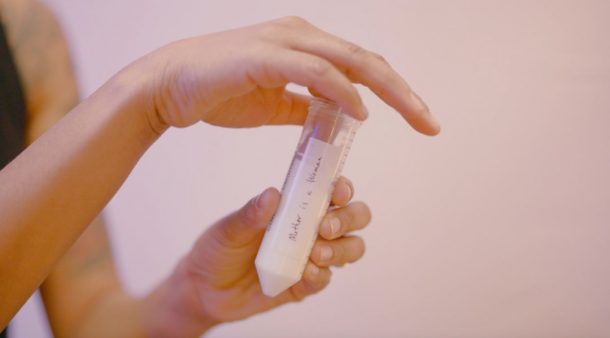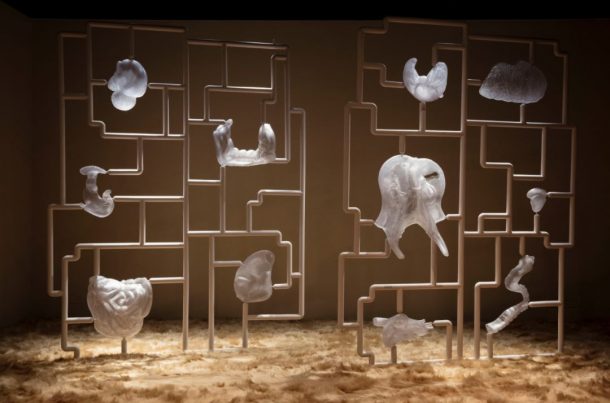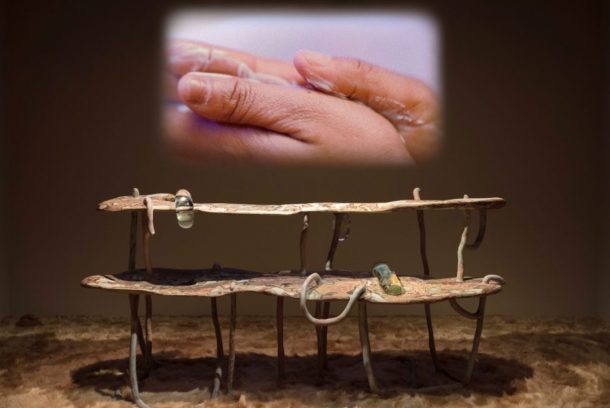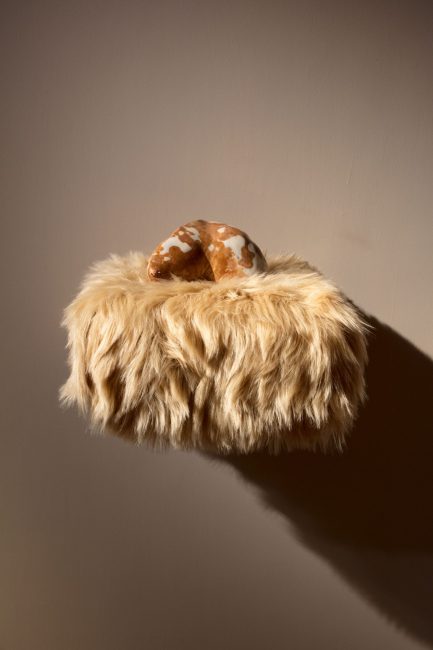JES FAN: Theory Forgets That We All Have Membranes
| May 31, 2018

Jes Fan, Mother Is A Woman, 2018, video, sound, color, 4 min 44 sec. Videographer: Asa Westcott.
What is a body made of, and how does that impact the way it is perceived? Does an impression of a body reflect its constitution? Artist Jes Fan posits these queries by investigating how the material science of a body, its minute makings, affects its external, overarching perception. Fan goes about their work by astutely eschewing the trendiness of burgeoning images or discourses around the body. Instead, they probe deeper into its fleshy, molecular insides for a more honest viscerality. This is not a teleological or predictable inquiry for Fan, but rather, an investigative, open-ended one. They do not appear to be interested in proving fact or buttressing widespread truths or assumptions about identity. Rather, they are rooted in the integrity of embodiment — what we are truly made of.
 Visible Woman, 2018, 3D printed resin, PPE pipes and pigments Diptych, 152 x 196 x 15cm each. Image courtesy of Empty Gallery
Visible Woman, 2018, 3D printed resin, PPE pipes and pigments Diptych, 152 x 196 x 15cm each. Image courtesy of Empty Gallery
In their recent exhibition at Hong Kong’s Empty Gallery, Fan intentionally transformed the gallery space by adorning the walls in flesh-toned hues and the floors in pink faux fur carpet. Tactility abounds in Fan’s environment. The gallery becomes a body, a vessel, ferrying its visitors on aqueous tunnels to other kinds of sensorial, skin-close encounters. Fan invokes embodiment in the very structure of the gallery itself. Their exhibition seems to inhabit our senses — it even looks and smells like a body. In a side room, walls drip with viscous prosthetic silicone, eerily resembling melting flesh. Slug-like glass globules snake around and over other installations, like animated organs exploring the insides of a body. Synthetic yet sensate, Fan’s spatial manipulation both evacuates and overwhelms notions of bodily presence. Their presentation recalls and yet is deeply estranged from the idea and image of a body.
 Diagram I (detailed), 2018, aqua resin, epoxy, aluminum, glass, and fiberglass, 110 x 218 x 51cm. Image courtesy of Empty Gallery
Diagram I (detailed), 2018, aqua resin, epoxy, aluminum, glass, and fiberglass, 110 x 218 x 51cm. Image courtesy of Empty Gallery
Discussions about the body and transgender life are inextricable. Although Fan does not avoid the matter of transgender identity, they complicate its trite representations by unearthing its rawest compositions. By employing soy beans and mimicking yams in many of their works, Fan heavily references two essential ingredients used to manufacture sex hormones. In the video work Mother Is A Woman, fingers seductively apply a plain white estrogen cream that Fan produced from their mother’s urine. In these works, Fan extracts the basal, unspectacular, and even scatological essence of transgender embodiment. As performance studies scholar Jeanne Vaccaro incisively observes: transgender is usually theorized as “transgressive” and “exceptional,” while “the everyday and unexceptional character of transgender experience receives little attention.” [1] Likewise, Fan introspectively reveals that what transgender people have to live with — hormones, guts, and excretions —actually helps them to live on a daily basis. In other words, Fan demonstrates how the utter ordinariness of transgender life is actually extraordinary and life-sustaining.
 View of “Jes Fan: Mother Is a Woman,” 2018, Empty Gallery, Hong Kong. Image courtesy of Empty Gallery
View of “Jes Fan: Mother Is a Woman,” 2018, Empty Gallery, Hong Kong. Image courtesy of Empty Gallery
Other works underscore the ripeness of banality as a medium for transgender fulfillment. Although appearing more outlandish than functional, Fan’s “Diagram” series look like shelves, tables, and benches, furniture that make a home livable. Theirs is a utilitarian surreality that accurately encapsulates the complexities and contradictions of lived transgender experiences. The surfaces of Diagram I have been sanded down to reveal a plethora of warm pinks, dulled whites, and earthy browns, each color indicating a different layer intrinsic to the material. Although dizzyingly psychedelic, this “Diagram” series thoroughly and straightforwardly illustrate the veracity of their constitution.

Forniphilia I, 2018, aqua resin, fiberglass, pigment, plywood, and artificial fur, 38 x 35 x 20cm. Image courtesy of Empty Gallery
The current fashionable understanding of “transgender,” or gender nonconformity more broadly, is unfortunately linked to a set of corresponding images that paradoxically demarcates and delimits what alternative genders and sexualities are supposed to look like. One has to prove they are authentically trans through their appearance and personal presentation. Furthermore, labeling an artist “transgender” or “queer” as a supposedly emancipatory gesture actually achieves the opposite effect, flattening the artist’s practice and reality to a passing fad. In contrast, Fan decouples the idea of transgender from its surface impressions, going, quite literally, beneath the surface, into its cellular make-up. As Fan ruminates: “theory forgets that we all have membranes,” alluding to the valuable perishability of our bodies.[2] In a cultural milieu obsessed with talking about and manifesting difference for the sake of being different, Fan literally withdraws into bodies that personify difference, discovering what makes them tick. Stripping away the ostentation of revelation and articulation, Fan presents the pungent offal of experience — flesh, fluids, odors, and organs — and by doing so delivers a nondescript, accountable experience of what it means to be transgender.
1.Vaccaro, Jeanne. ‘Felt Matters,’ in The Transgender Studies Reader 2, ed. Susan Stryker and Aren Aizura, pp. 91-100. New York: Routledge, 2013.
2.Skype conversation with artist.

